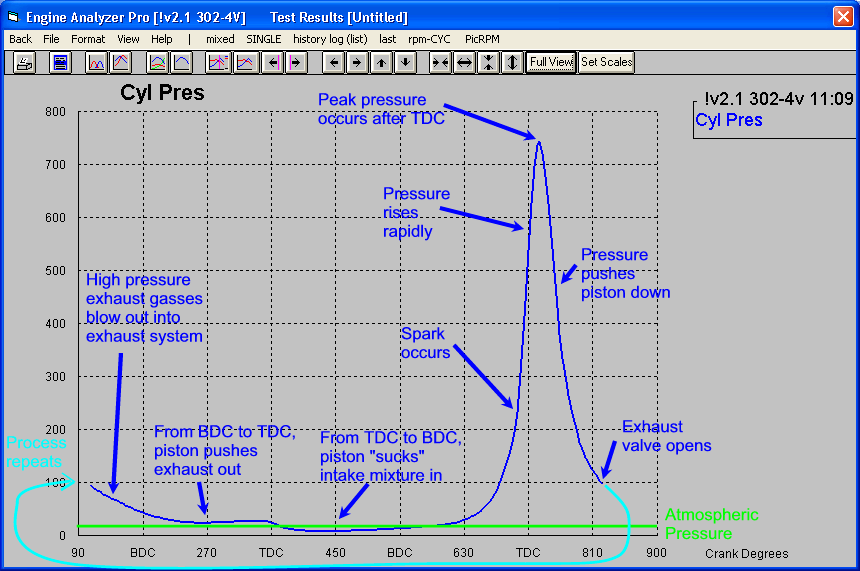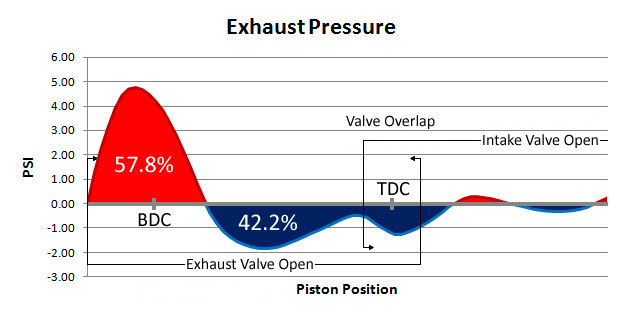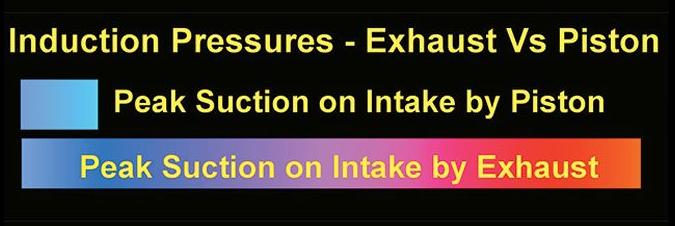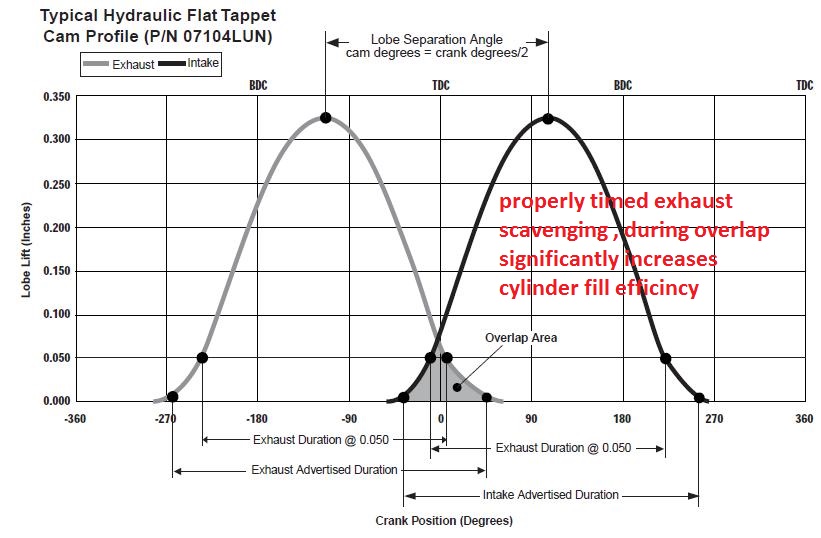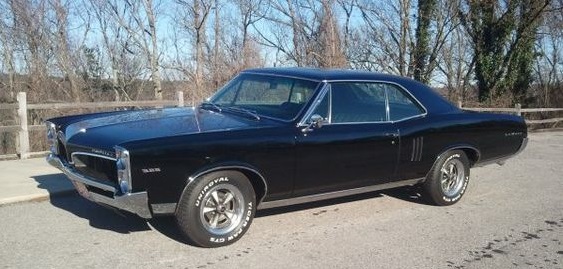more numbers for ya'll who like numbers.
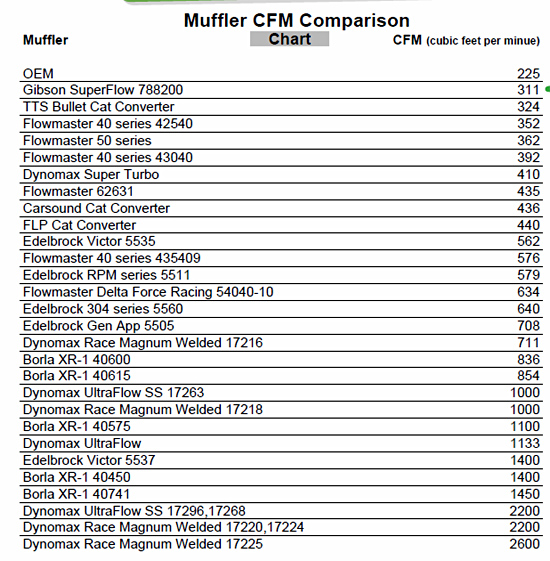
All tests via an independent lab
All tests @ 15” wc
2 “ Straight Pipe 283 CFM
2 ¼ “ Straight Pipe 365 CFM
2 ½ “ Straight Pipe 521 CFM
2 ¼” Typical Bent tailpipe 268 CFM
2 ½” Typical Bent Tailpipe 417 CFM
2 ¼” Inlet/Outlet_ Glass Pack Tips- No Louvers- Smooth 274 CFM
2 ¼” Inlet/Outlet- Glass Pack Tips-Louvered 133 CFM
Same as above set for reverse flow 141 CFM
2 ¼” Cherry Bomb 239 CFM
2 ½” Cherry Bomb 294 CFM
2 ½” Inlet/Outlet Dynomax Super Turbo 278 CFM
2 ½” Inlet/Outlet Ultraflow Bullet 512 CFM
2 ½” Inlet/Outlet Gibson Superflow 267 CFM
2 ½” Inlet/Outlet Flowmaster ( 2 Chamber) 249 CFM
2 ½” Inlet Outlet Flowmaster ( 3 Chamber) 229 CFM
2 ¼” Inlet/Outlet Thrush CVX 260 CFM
2 ½” Inlet/Outlet Maremount Cherry Bomb 298 CFM
2 ½” Inlet/Outlet Hooker Aero Chamber 324 CFM
2 ½” Inlet/Outlet Hooker Max Flow 521 CFM
2 ½” Inlet/Outlet Borla Turbo 373 CFM
2 1/2" Inlet/Outlet Magnaflow 284 CFM
http://www.pontiacstreetperformance.com/psp/exhaust.html
http://www.mk5cortinaestate.co.uk/calculator5.php
http://forums.superchevy.com/super-...-calculate-muffler-size-and-exhaust-pipe-dia/
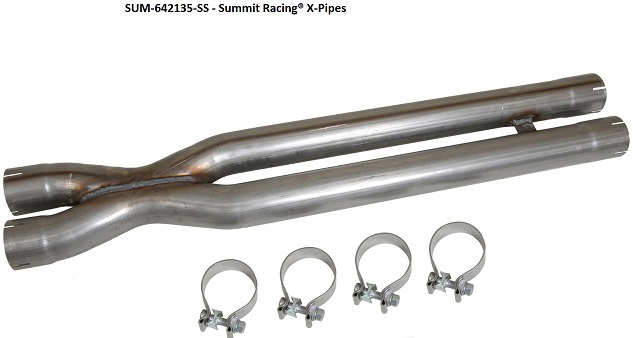
Standard OEM 2 ¼” Inlet/Outlet 138-152 CFM
Standard OEM 2 ½” Inlet/Outlet 161-197 CFM
this may provide some perspective when designing your exhaust setups and choosing muflers.
I don,t remember if the 440 six pack road runners came with a 2.5" or a 3" dual exhaust, (IM THINKING 2.5" was OEM installed)
but a well designed 3" and correctly installed dual exhaust , mounted behind a set of decent brand name long tube headers ,will certainly provide you with a low restriction option that won,t restrict your new increased power.
ID point out that adding a 3" (X) pipe, rather than the (H) pipe and carefully selecting low restriction mufflers may help reduce the flow restriction.
any automotive engine will run best with little or no back pressure on the exhaust system ,
back pressure ALWAYS tends to reduce the cylinder fill and scavenging efficiency, this is not a guessing game.
you can simply measure back pressure in the exhaust every500 rpm from about 3000rpm to where ever your upper rpm limit lies, and if its ever over about 2 psi your losing power.
in fact in a properly designed exhaust system you'll ideally run a negative pressure behind the exhaust valves as they open,
helping the exhaust scavenge the cylinders, over most of the peak rpm range.
thus any significant back pressure is always going to reduce the potential power.
a correctly designed exhaust header can induce a low or negative pressure wave at the exhaust port as the exhaust valve opens to greatly increase cylinder scavenging and cylinder fill efficiency over a carefully designed in rpm band of a correctly tuned engine, provided the other factors like compression,cam timing and a low restriction exhaust system past the header collectors are used in a well matched combo. you can get a very good idea
http://www.jegs.com/i/JEGS/555/3051...9&cadevice=c&gclid=CPG-04_Ev8cCFRaAkQodVa8LdQ
http://www.jegs.com/i/Flowmaster/389/943050/10002/-1
http://garage.grumpysperformance.com/index.php?threads/header-dimension-calculator.15013/
http://www.jegs.com/i/Flowmaster/389/843041/10002/-1
http://www.summitracing.com/parts/flo-17382/overview/year/1970/make/plymouth/model/roadrunner
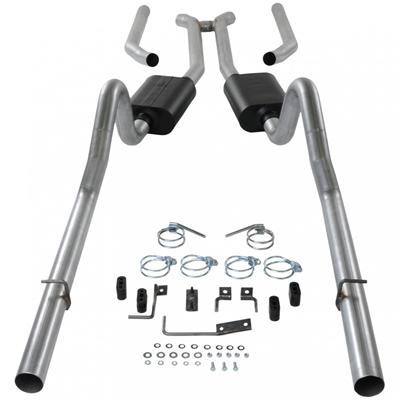
http://www.asia.donaldson.com/en/exhaust/support/datalibrary/1053747.pdf
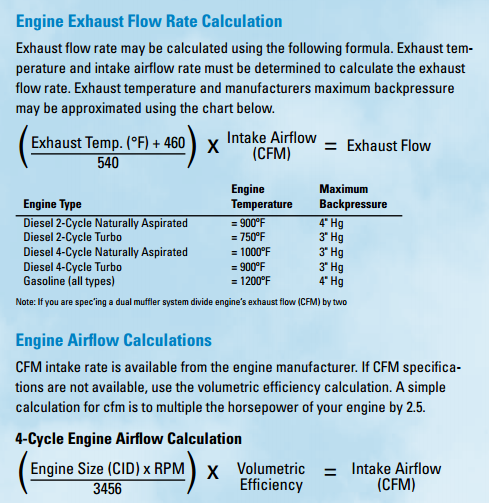
in the ideal exhaust system youll want to have less than .5
(thats 1/2 a PSI of back pressure) at the engines peak rpm

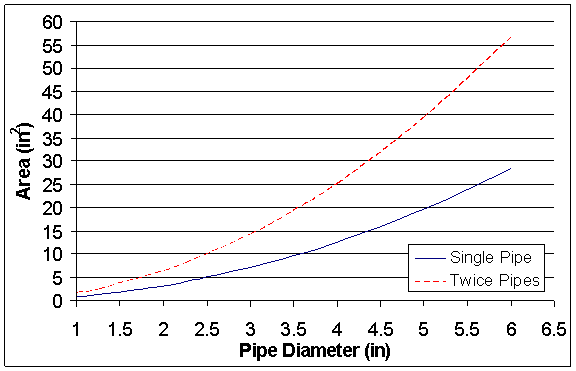
http://www.exhaustvideos.com/faq/how-to-calculate-muffler-size-pipe-diameter/
http://www.mk5cortinaestate.co.uk/calculator5.php


h-pipes are no where near as efficient or effective at equalizing or reducing individual, bank to bank exhaust pulse strength,or reducing the restriction to exhaust flow, as a similarly placed (X-pipe )
if you have the room two (X-PIPES in sequence have been repeatedly been tested,
and repeatedly found to provide a minor but measurably better result in increasing cylinder scavenging and a mellower exhaust sound
your not going to see any huge gains from either configuration, but a single (X-pipe generally produces a bit better and a wider torque curve ,
and two x-pipes in series is not all that rare recently even on the higher end performance cars
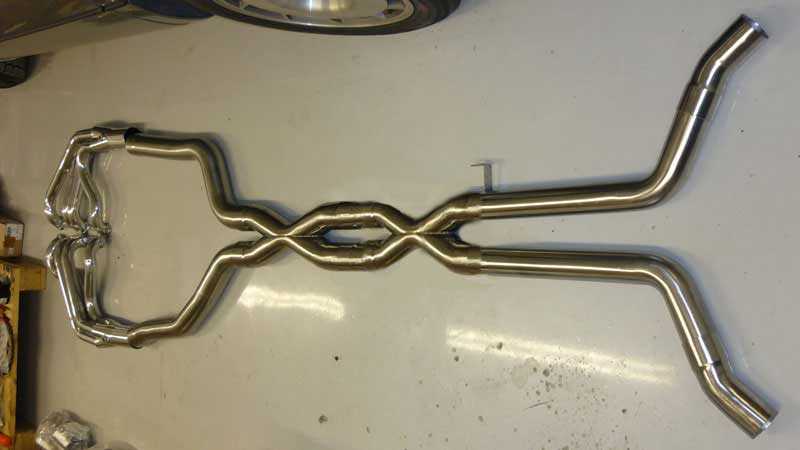
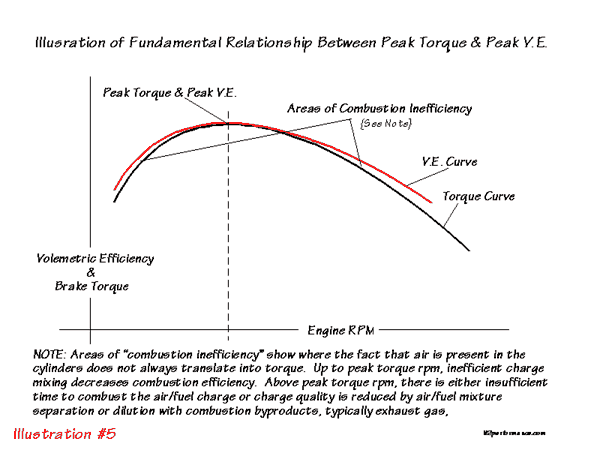
3" o.d = 2.87" diam. inside--approximately 6.5 sq inches of area
2.75 o.d = 2.62"diam. inside--approximately 5.4 sq inches of area
2.5 o.d = 2.37" diam. inside--approximately 4.4 sq inches of area
2.25 o.d = 2.12" diam. inside--approximately 3.5 sq inches of area
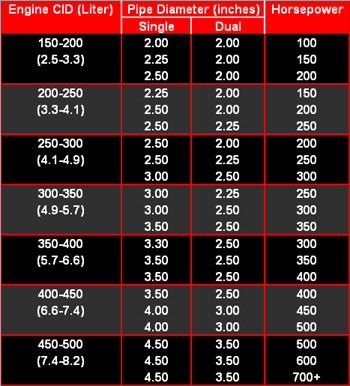
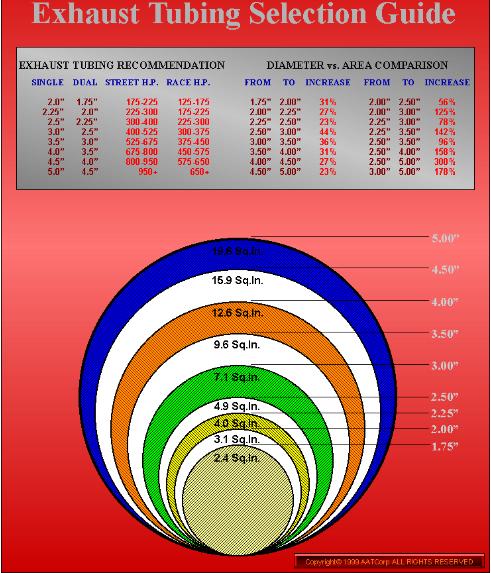
well worth reading
http://www.popularhotrodding.com/engine ... ndex1.html
http://garage.grumpysperformance.com/index.php?threads/exhaust-components.361/

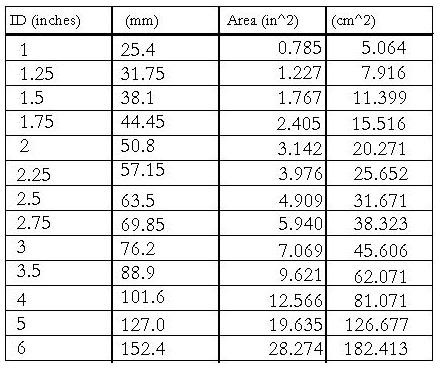
http://garage.grumpysperformance.com/index.php?threads/calculating-required-exhaust-pipe-size.11552/
http://garage.grumpysperformance.co...-exhaust-pipe-diam-for-your-application.1730/
http://garage.grumpysperformance.com/index.php?threads/is-backpressure-hurting-your-combo.495/
http://garage.grumpysperformance.com/index.php?threads/building-an-exhaust-system-for-your-car.1166/
http://garage.grumpysperformance.co...-calculators-and-basic-math.10705/#post-72061
http://www.wallaceracing.com/Calculators.htm
http://garage.grumpysperformance.com/index.php?threads/header-dimension-calculator.15013/
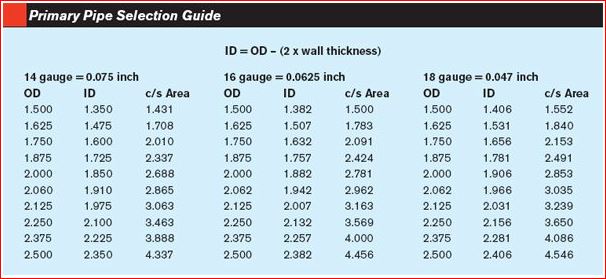
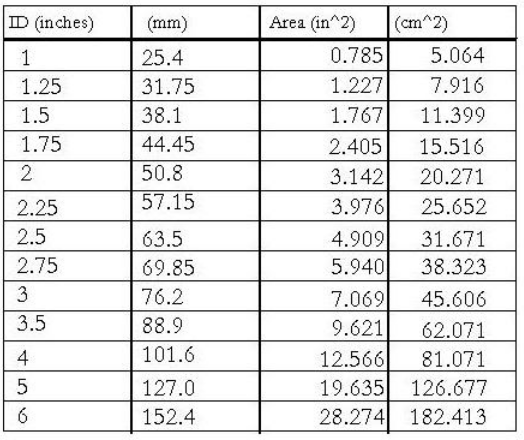
keep in mind installing an (X) almost increases the effective cross sectional area, of the dual exhaust ,or collector cross sectional area to double what it had been behind a single header collector, by doubling the area that the exhaust flow sees, dropping the restriction to flow almost in half
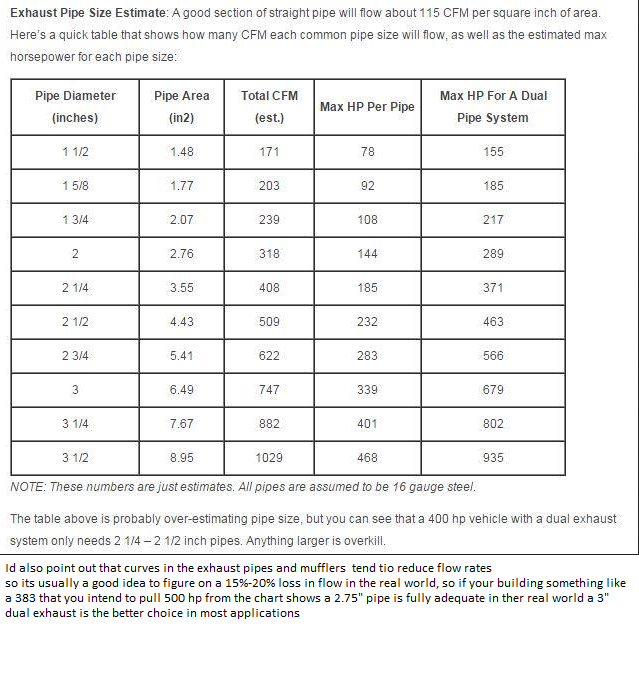
adding an anti-reversion baffle to a 18"-24" longer collector on open headers with the internal pipe about 1/2 the collector length tends to help scavenging on some engines
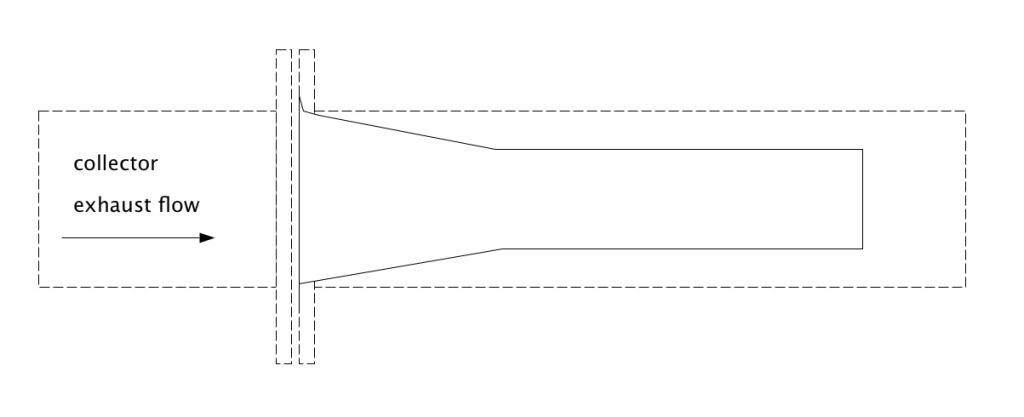
these threads go into more details, READING THE LINKED INFO HELPS
exhaust flow is never constant it comes in pulses that vary in pressure , some what in volume and timing or duration as the rpms change, thus the ideal cross sectional area required in the exhaust header and exhaust pipe,
for a given engine displacement and rpm also varies
your also dealing in most cases with an un-equalized firing order where each cylinder bank does not always alternate equally.
thus two properly sized exhaust headers blending and flowing into an x-pipe to dual exhaust beyond will generally provide a slight improvement over a single merged exhaust.
http://garage.grumpysperformance.com/index.php?threads/calculating-required-exhaust-pipe-size.11552/
http://garage.grumpysperformance.com/index.php?threads/x-or-h-pipe.1503/
http://garage.grumpysperformance.com/index.php?threads/is-backpressure-hurting-your-combo.495/
http://garage.grumpysperformance.com/index.php?threads/calculating-header-design.185/
http://garage.grumpysperformance.co...-03-12-with-wave-action-analysis.15764/page-2
http://garage.grumpysperformance.com/index.php?threads/that-annoying-exhaust-drone.5001/#post-42468
http://garage.grumpysperformance.com/index.php?threads/building-an-exhaust-system-for-your-car.1166/
http://garage.grumpysperformance.com/index.php?threads/is-backpressure-hurting-your-combo.495/
http://garage.grumpysperformance.co...ipe-diam-for-your-application.1730/#post-5242
http://garage.grumpysperformance.co...troker-probably-in-the-future.1111/#post-2201
read related threads,
as they contain a great deal more related and useful info
http://garage.grumpysperformance.com/index.php?threads/spiral-mufflers-anyone.10365/#post-42725
http://garage.grumpysperformance.com/index.php?threads/calculating-header-design.185/
http://garage.grumpysperformance.com/index.php?threads/c3-side-pipe-exhausts.793/#post-1150
http://garage.grumpysperformance.co...ders-that-work-with-sidepipes.2350/#post-6204
http://garage.grumpysperformance.co...lap-on-factory-headers.3155/page-2#post-66721

All tests via an independent lab
All tests @ 15” wc
2 “ Straight Pipe 283 CFM
2 ¼ “ Straight Pipe 365 CFM
2 ½ “ Straight Pipe 521 CFM
2 ¼” Typical Bent tailpipe 268 CFM
2 ½” Typical Bent Tailpipe 417 CFM
2 ¼” Inlet/Outlet_ Glass Pack Tips- No Louvers- Smooth 274 CFM
2 ¼” Inlet/Outlet- Glass Pack Tips-Louvered 133 CFM
Same as above set for reverse flow 141 CFM
2 ¼” Cherry Bomb 239 CFM
2 ½” Cherry Bomb 294 CFM
2 ½” Inlet/Outlet Dynomax Super Turbo 278 CFM
2 ½” Inlet/Outlet Ultraflow Bullet 512 CFM
2 ½” Inlet/Outlet Gibson Superflow 267 CFM
2 ½” Inlet/Outlet Flowmaster ( 2 Chamber) 249 CFM
2 ½” Inlet Outlet Flowmaster ( 3 Chamber) 229 CFM
2 ¼” Inlet/Outlet Thrush CVX 260 CFM
2 ½” Inlet/Outlet Maremount Cherry Bomb 298 CFM
2 ½” Inlet/Outlet Hooker Aero Chamber 324 CFM
2 ½” Inlet/Outlet Hooker Max Flow 521 CFM
2 ½” Inlet/Outlet Borla Turbo 373 CFM
2 1/2" Inlet/Outlet Magnaflow 284 CFM
http://www.pontiacstreetperformance.com/psp/exhaust.html
http://www.mk5cortinaestate.co.uk/calculator5.php
http://forums.superchevy.com/super-...-calculate-muffler-size-and-exhaust-pipe-dia/

Standard OEM 2 ¼” Inlet/Outlet 138-152 CFM
Standard OEM 2 ½” Inlet/Outlet 161-197 CFM
this may provide some perspective when designing your exhaust setups and choosing muflers.
allen said:OK I'm a bit confused I'll certainly admit that!
Im trying to figure out if I need to upgrade the exhaust pipe size on my 440 dodge now that I have added several performance parts and probably added about 120 more hp?
now keep in mind thats on the engine builders estimate , the original engine was rated at 390hp / 490 ft lbs, so in theory I have 500 hp or a bit more, but it was originally a 3x2 bbl engine but when I got the car it had a 440 engine block from a different car and the 3x2 intakes long gone also.
on the plus side, its a forged crank,better connecting rods,and I now have 11:1 compression, better cylinder heads,than the original engine had, and a radical hydraulic roller cam....any ideas ?
I don,t remember if the 440 six pack road runners came with a 2.5" or a 3" dual exhaust, (IM THINKING 2.5" was OEM installed)
but a well designed 3" and correctly installed dual exhaust , mounted behind a set of decent brand name long tube headers ,will certainly provide you with a low restriction option that won,t restrict your new increased power.
ID point out that adding a 3" (X) pipe, rather than the (H) pipe and carefully selecting low restriction mufflers may help reduce the flow restriction.
any automotive engine will run best with little or no back pressure on the exhaust system ,
back pressure ALWAYS tends to reduce the cylinder fill and scavenging efficiency, this is not a guessing game.
you can simply measure back pressure in the exhaust every500 rpm from about 3000rpm to where ever your upper rpm limit lies, and if its ever over about 2 psi your losing power.
in fact in a properly designed exhaust system you'll ideally run a negative pressure behind the exhaust valves as they open,
helping the exhaust scavenge the cylinders, over most of the peak rpm range.
thus any significant back pressure is always going to reduce the potential power.
a correctly designed exhaust header can induce a low or negative pressure wave at the exhaust port as the exhaust valve opens to greatly increase cylinder scavenging and cylinder fill efficiency over a carefully designed in rpm band of a correctly tuned engine, provided the other factors like compression,cam timing and a low restriction exhaust system past the header collectors are used in a well matched combo. you can get a very good idea
http://www.jegs.com/i/JEGS/555/3051...9&cadevice=c&gclid=CPG-04_Ev8cCFRaAkQodVa8LdQ
http://www.jegs.com/i/Flowmaster/389/943050/10002/-1
http://garage.grumpysperformance.com/index.php?threads/header-dimension-calculator.15013/
http://www.jegs.com/i/Flowmaster/389/843041/10002/-1
http://www.summitracing.com/parts/flo-17382/overview/year/1970/make/plymouth/model/roadrunner

http://www.asia.donaldson.com/en/exhaust/support/datalibrary/1053747.pdf

in the ideal exhaust system youll want to have less than .5
(thats 1/2 a PSI of back pressure) at the engines peak rpm


http://www.exhaustvideos.com/faq/how-to-calculate-muffler-size-pipe-diameter/
http://www.mk5cortinaestate.co.uk/calculator5.php

h-pipes are no where near as efficient or effective at equalizing or reducing individual, bank to bank exhaust pulse strength,or reducing the restriction to exhaust flow, as a similarly placed (X-pipe )
if you have the room two (X-PIPES in sequence have been repeatedly been tested,
and repeatedly found to provide a minor but measurably better result in increasing cylinder scavenging and a mellower exhaust sound
your not going to see any huge gains from either configuration, but a single (X-pipe generally produces a bit better and a wider torque curve ,
and two x-pipes in series is not all that rare recently even on the higher end performance cars


3" o.d = 2.87" diam. inside--approximately 6.5 sq inches of area
2.75 o.d = 2.62"diam. inside--approximately 5.4 sq inches of area
2.5 o.d = 2.37" diam. inside--approximately 4.4 sq inches of area
2.25 o.d = 2.12" diam. inside--approximately 3.5 sq inches of area


well worth reading
http://www.popularhotrodding.com/engine ... ndex1.html
http://garage.grumpysperformance.com/index.php?threads/exhaust-components.361/


http://garage.grumpysperformance.com/index.php?threads/calculating-required-exhaust-pipe-size.11552/
http://garage.grumpysperformance.co...-exhaust-pipe-diam-for-your-application.1730/
http://garage.grumpysperformance.com/index.php?threads/is-backpressure-hurting-your-combo.495/
http://garage.grumpysperformance.com/index.php?threads/building-an-exhaust-system-for-your-car.1166/
http://garage.grumpysperformance.co...-calculators-and-basic-math.10705/#post-72061
http://www.wallaceracing.com/Calculators.htm
http://garage.grumpysperformance.com/index.php?threads/header-dimension-calculator.15013/

keep in mind installing an (X) almost increases the effective cross sectional area, of the dual exhaust ,or collector cross sectional area to double what it had been behind a single header collector, by doubling the area that the exhaust flow sees, dropping the restriction to flow almost in half

adding an anti-reversion baffle to a 18"-24" longer collector on open headers with the internal pipe about 1/2 the collector length tends to help scavenging on some engines

these threads go into more details, READING THE LINKED INFO HELPS
exhaust flow is never constant it comes in pulses that vary in pressure , some what in volume and timing or duration as the rpms change, thus the ideal cross sectional area required in the exhaust header and exhaust pipe,
for a given engine displacement and rpm also varies
your also dealing in most cases with an un-equalized firing order where each cylinder bank does not always alternate equally.
thus two properly sized exhaust headers blending and flowing into an x-pipe to dual exhaust beyond will generally provide a slight improvement over a single merged exhaust.
http://garage.grumpysperformance.com/index.php?threads/calculating-required-exhaust-pipe-size.11552/
http://garage.grumpysperformance.com/index.php?threads/x-or-h-pipe.1503/
http://garage.grumpysperformance.com/index.php?threads/is-backpressure-hurting-your-combo.495/
http://garage.grumpysperformance.com/index.php?threads/calculating-header-design.185/
http://garage.grumpysperformance.co...-03-12-with-wave-action-analysis.15764/page-2
http://garage.grumpysperformance.com/index.php?threads/that-annoying-exhaust-drone.5001/#post-42468
http://garage.grumpysperformance.com/index.php?threads/building-an-exhaust-system-for-your-car.1166/
http://garage.grumpysperformance.com/index.php?threads/is-backpressure-hurting-your-combo.495/
http://garage.grumpysperformance.co...ipe-diam-for-your-application.1730/#post-5242
http://garage.grumpysperformance.co...troker-probably-in-the-future.1111/#post-2201
read related threads,
as they contain a great deal more related and useful info
http://garage.grumpysperformance.com/index.php?threads/spiral-mufflers-anyone.10365/#post-42725
http://garage.grumpysperformance.com/index.php?threads/calculating-header-design.185/
http://garage.grumpysperformance.com/index.php?threads/c3-side-pipe-exhausts.793/#post-1150
http://garage.grumpysperformance.co...ders-that-work-with-sidepipes.2350/#post-6204
http://garage.grumpysperformance.co...lap-on-factory-headers.3155/page-2#post-66721
Last edited:

